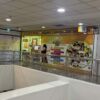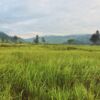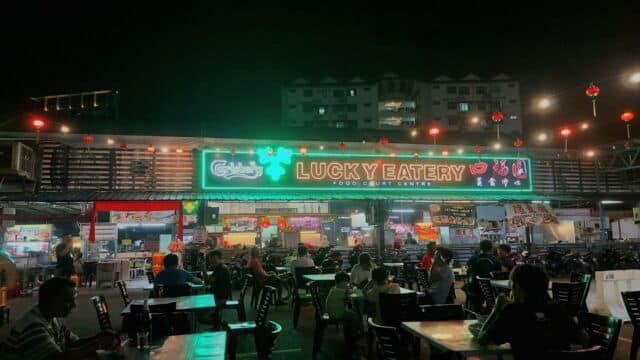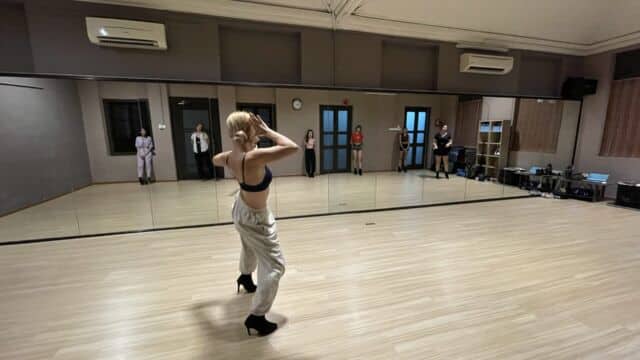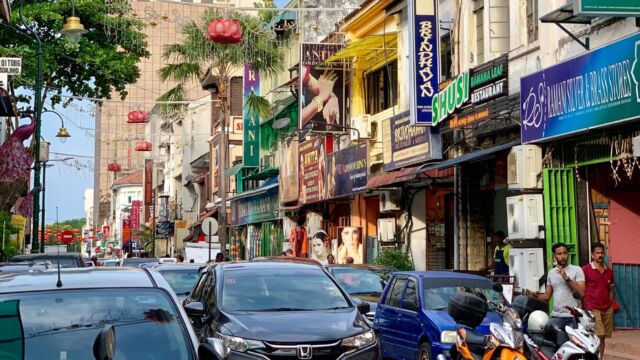Penang’s Bridges Are Passages to Another World
"Penang Bridge" by Ah Wei (Lung Wei), Flickr, is licensed under CC BY-SA 4.0
Penang | 3,051 words
When I think about Penang, I think about the bridge. It’s thirteen kilometers long, with triangular metal frames in the middle. I always thought the frames looked like giant samosas, two on the left, two on the right. The engineers call it a cable-stayed bridge, and the samosas a “fan design”. But how is a child to know all that?
A bridge represents a gateway, a passage to another world. When it opened in 1985, a year before I was born, people parked their cars by the left lane and took photos leaning against the parapet, the South Channel in the background.
I know because there is a photo of my parents, with my two older sisters, the eldest one wearing a red pinafore dress, the younger one wearing cotton pants and a Mickey Mouse t-shirt, their eyes small and faces scrunched up in the sun.
The bridge was an architectural marvel, and Pos Malaysia issued a First Day Cover to commemorate its opening. 20 cents, 40 cents, one dollar stamps. Except that 20 workers were killed during construction, with many more deaths to come from car crashes and suicides.
An accident on the bridge meant my father would be late home from work. My mother would keep his dinner aside: a portion of rice in the electric rice cooker, a vegetable dish and a meat dish placed under a plastic tudung saji, a food cover. A pot of soup in the back kitchen, to be heated up on the gas stove when he was home.
The bridge is a boon and a bane. At the age of 12, I realized that my father lived with another woman on the mainland. They had two children, school-age, a little younger than myself and my younger sister. I marveled at the bridge, an architectural wonder. I feared it too, for it connected me to a world I did not want to know about.
Now there’s two of them. Two bridges. But bridges or not, invaders will always come.
*
Before the first bridge was born, the island was connected to the mainland by steam engine ferries. Similar to Hong Kong’s Star Ferry, the double-deckers started in the 1920s and were able to carry automobiles. The roll-on roll-off ships died during the pandemic, but the memories didn’t.
It was the white foam and the sound it made, shh shh shh. It was the feel of rubber flip-flops on metal, running up the steps to the top floor, where wooden benches sat glued to the surface like in a school canteen.
It was avoiding the bird poo on the railings and pointing at the yellow cranes in Seberang Perai that my sister called “giraffes”. It was the men turning off their car engines, rolling the windows down and stretching their seats back for a short nap, the smell of salt and mud in the breeze everywhere.
It was the sound of engines starting again, doors slamming, and the feel of the first bump when the ferry touched the platform, when everyone shook just a little bit. Then, the gedung gedung gedung of wheels on metal plates, one car at a time, spilling out from ship to ground.
We lived on the island, but worked on the mainland. Then we worked on the mainland, and lived on the island. For a while, we lived on the mainland, then went to school on the island. After my mother had four children, it was better to pick a side. We chose the island. But the breadwinner remained, and there emerged his double life.
I was born on the mainland, in a place called Raja Uda in Butterworth. It was chaotic, working-class and Chinese-speaking; all the things I did not want to be. I was born in a maternity clinic on Jalan Chain Ferry, which gets its name from—you guessed it—olden-day rafts pulled with chains across the Perai River, ferrying commuters from the Inderawasih side to the Kampung Nyiur side.
Raja Uda is now, and has always been, a hub for good food. Tom yam by the tree, curry mee, steamboat, Western food, seafood restaurants, cornershop kopitiams. You’ve not been to Raja Uda? What kind of Penangite are you? You don’t like food? But you’re from Penang! And so the questions go, like those aimed at the Britisher who doesn’t drink tea.
*
Penang is a tough nut to crack. The pinang it took its name from is, after all, an areca nut, also known as a betel nut. To open a young pinang fruit, a scissor-like cutter is used, like a press-knife that looks more like a plier or a modern-day crab leg cracker. Then, it’s wrapped with betel leaves, spread with slaked lime and sprinkled with cloves, chewed as a stimulant that causes mouth cancer.
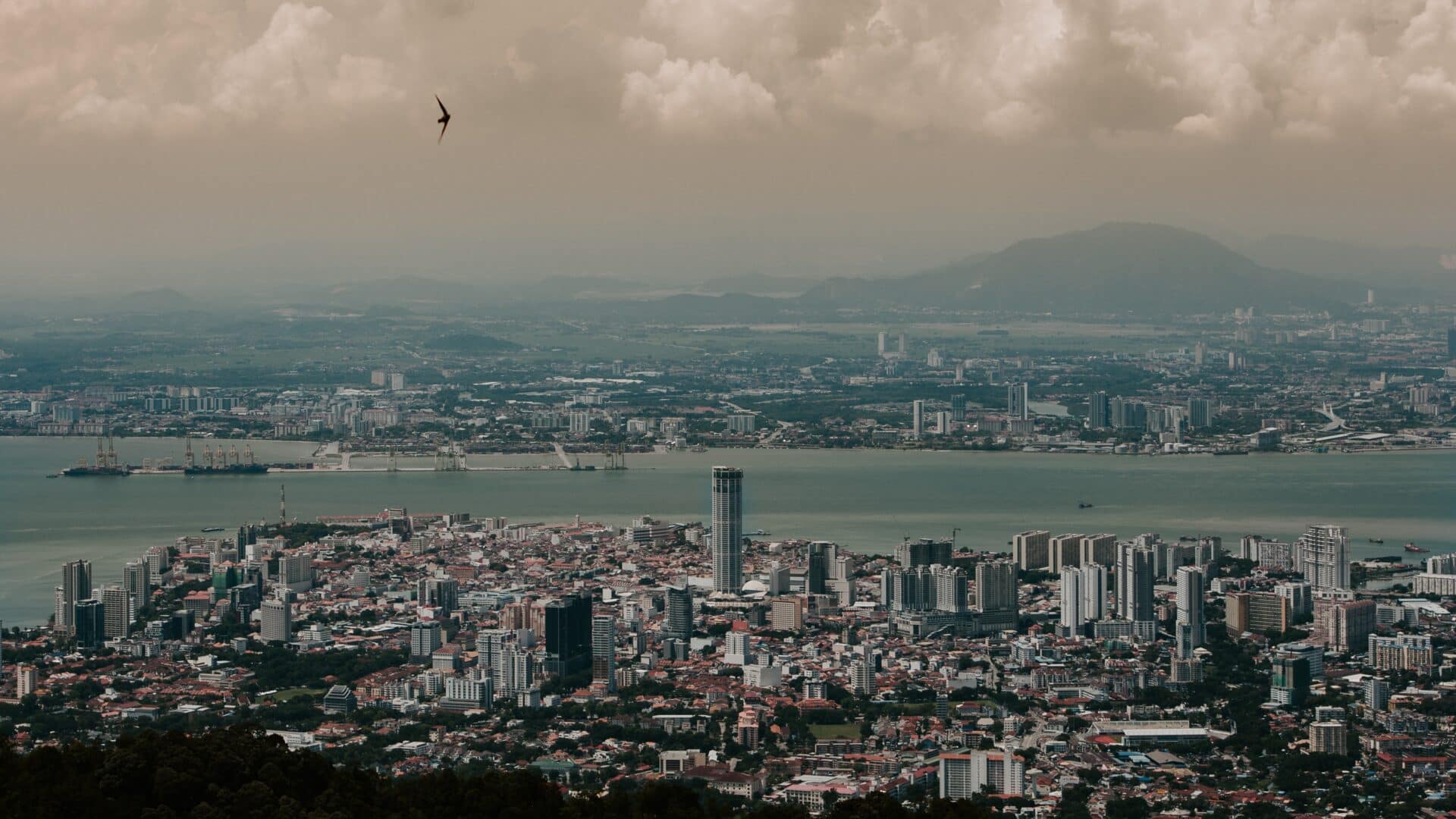
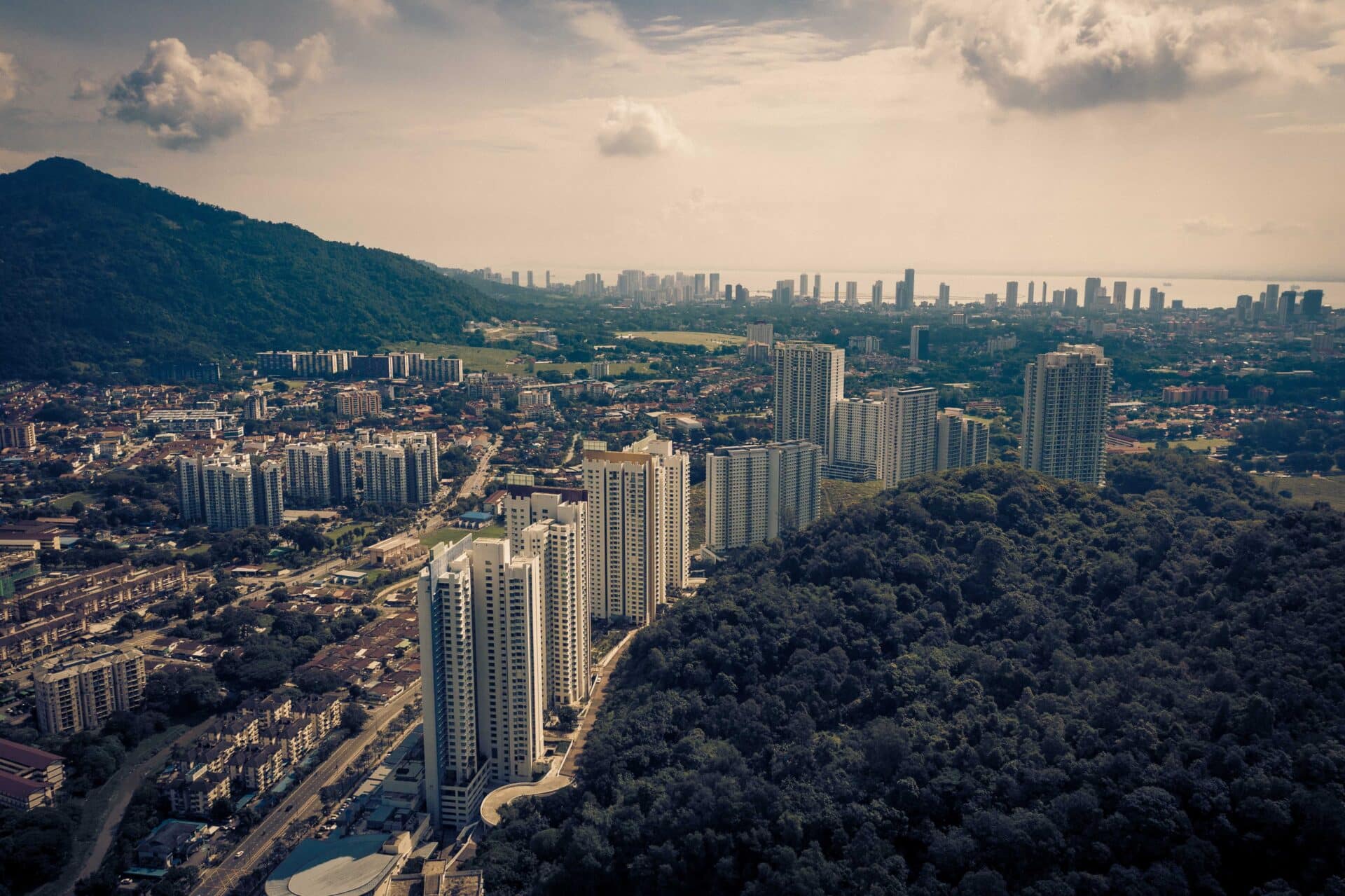
The island is a turtle-shape, and Taman Sungai Ara lies by its belly on the right. A large portion of the turtle’s spine is covered by forests and hills, and here I lived sheltered by the foothills—away from the mainland, away from the rest of Peninsular Malaysia, away from reality. Perhaps this is what they call the “island mentality.”
For 18 years, I lived in a bubble on the island, in a Double-Storey Detached House Type B in a then-new estate called Taman Sungai Ara. As it was altered and renovated over those years, the language of the architects who went to work on it changed—from “Ground Floor Plan” and “Front Elevation” to “Pelan Lantai Tingkat Bawah” and “Tampak Hadapan”—as Bahasa Malaysia replaced English in all areas of civic and professional life. At six years old, I remember standing by the glass sliding doors in the living room of our new home, hearing sounds and feeling tremors on the panels. Little did I know that they came from rocks being blasted. Taman Sungai Ara was growing. I saw a flying squirrel with reddish fur only once, while going up the hills with my father and sister.
By the mid-1990s, alterations were made to House Type B and we became a home of parties. Catered buffets with red and white marquees, where chefs in white hats and white uniforms dished out food from large silver trays with round lids that swung open and closed to keep the food warm. Eden Catering, the pinnacle of every house party and “Malaysia’s Preferred Caterer.”
Neighbours, relatives and family friends came. Bankers, lawyers and accountants came—business acquaintances turned friends. That was how it worked in their generation. Work and home life were not separate.
We were a home of birthday parties and Christmas parties, including the hiring of a magician named Barry Khoo for my sister’s fourth birthday. The children sat on a cloth on the grass and watched Barry Khoo twist long strips of colored balloons into poodles and swords.
Coca-Colas were drunk from twisty, spirally plastic straws, and paper umbrellas stuck out from our “cocktail” juices. White styrofoam boxes were filled with ice and placed on the floor. Inside were cans of Sarsi, Sprite, 7-Up, Fanta Oren, F&N Grape, Anglia Shandy <1.0% alcohol for teenagers who wanted to be adults, and Tiger, Carlsberg and Heineken for the actual adults.
And yet, and yet. One could not remain a child forever. The Fanta had to give way to the Shandy and the Carlsberg, and childhood could not shield me forever.
*
Each year when I came home from university, something would change. We no longer go to Kompleks Bukit Jambul, my mother would say. It’s for foreign workers now. The apong man in Jelutong Market has died, she would say. His son has taken over but his girlfriend is complaining.
Can you imagine those young ones being hawkers? she said. Standing in the heat, the girl’s makeup melting. And it’s only apong, batter pre-mixed at home. We’re not even talking about char koay teow or char koay kak. No, I shook my head. I couldn’t, so why would they?
Each year when I came home from working in Singapore, a condominium was erected in Sungai Ara. There’s now Golden Triangle, Imperial Ville, Skycube Residence, Zan Ara and Senz Villes. Names that don’t make sense, except if one’s goal is to sound vaguely Western or European. Perhaps like Arte S Condominium in nearby Gelugor, or naming your child Chloez. Who am I to judge?
I went to school with girls who had names like Philomena, Jochebed and Natasha Lauren. A senior from the Drama Club even confessed to me how much she hated her Chinese name, Gaik. It means “jade” in Hokkien, and I thought it was beautiful. But I could see why she hated it. It was better to be Valerie.
School in Green Lane was another bubble, a colonial institution established by Roman Catholic missionaries from France. With no more Infant Jesus Sisters or nuns by the 1990’s, we were still taught by teachers who spoke only English, themselves recipients of missionary education. They taught and explained history, geography, biology, physics and chemistry in English, while reading from Bahasa Malaysia textbooks.
In Green Lane, I went to school with children of doctors, lawyers, engineers and chartered accountants. They were Island Gladers and children of university professors, lecturers and teachers—the educated class. Few of them had a father who was an industrialist who never went to college, and a classmate even expressed disdained surprise that I could speak Hokkien.
Green Lane was only 13 kilometers away from Sungai Ara, but it left a large imprint in my mind and my psyche. It’s where I spent 11 years from the age of seven to 17, and it’s where I would go walking around after school in the hot afternoon sun.
There, I wandered into gazetted estates called “Rumah Kerajaan”, government homes built for civil servants. I admired their small homes on large green lawns, and I studied their modernism and functionalist architectural style—thin concrete fins, air vents that looked like little pipe holes, light green glass pane windows and a geometric façade, protected by low, flimsy metal gates.
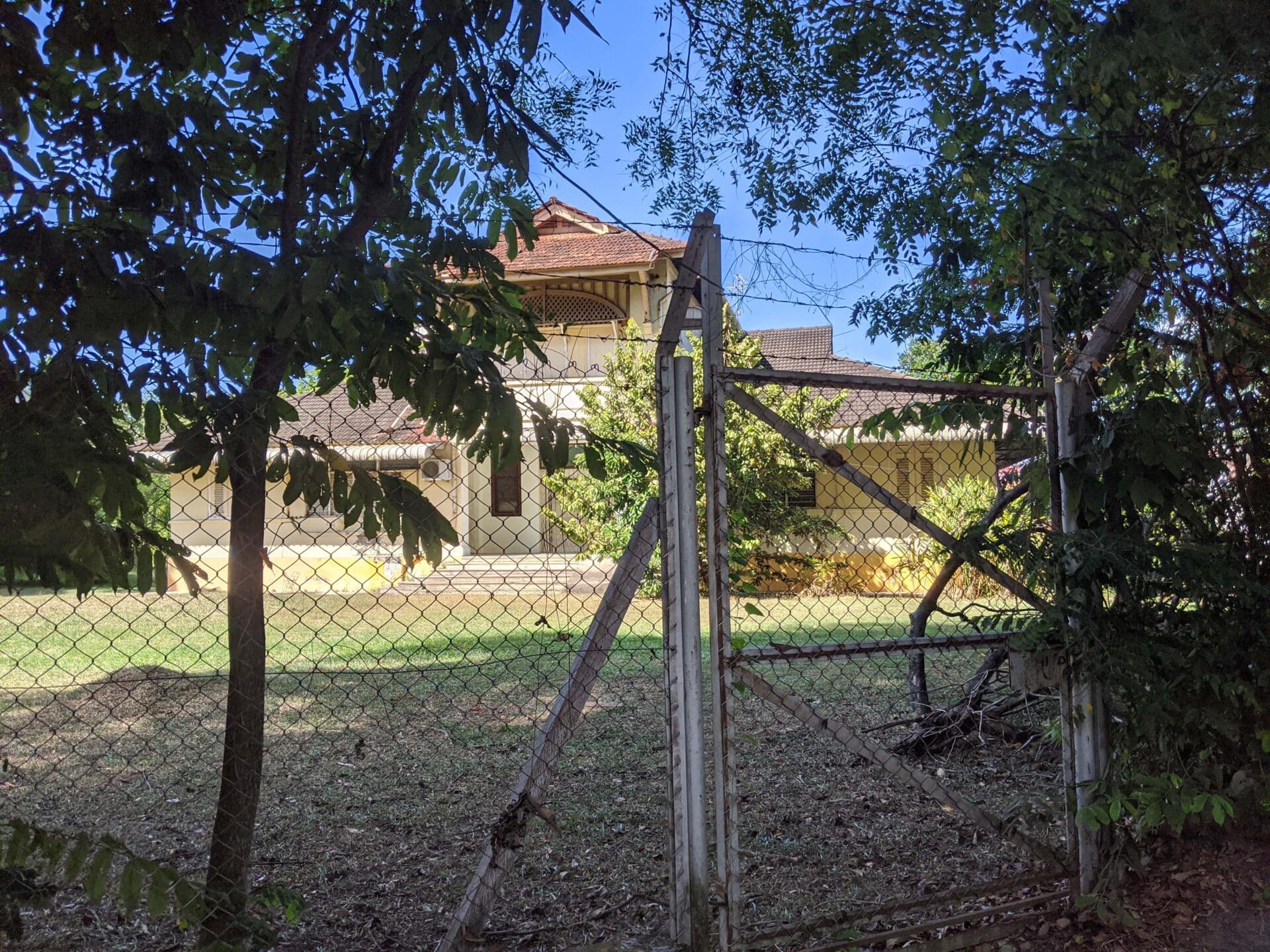
I imagined the soft curtains blowing against their wooden sideboards, feet cooling on mosaic tiles, coffee cups and saucers clinking, newspapers and afternoon naps. There, I walked around in my school uniform, shaded by the tall angsana trees, sometimes with a friend, sometimes without. My wandering and dreaming began at an early age. In some seasons, the Flame of the Forest trees dropped yellow flowers that littered the ground like a golden carpet.
*
Every year, the girls from my school try to meet up for a reunion, and guess where we go. It’s to the McDonald’s on Green Lane next to school, Drive-Thru McCafé Open 24 Hours, the big golden M a beacon of comfort, safety and familiarity.
Except we’re no longer girls in dark blue pinafores, carrying coin purses and cotton handkerchiefs in our pockets. Or wearing crisp white shirts and white shoes that were impossible to keep clean while running around the school field playing monkey, “touching” or la la li la tam pong, ah pek beh ah pong, ah pong tim lok hai, ah pek chiak kau sai.
We are no longer girls holding hands to go to the toilet in pairs, or arguing about whether babies came out of the stomach or somewhere else. Most of us are mums now—engineers, artists, financiers, sales people, stay-at-home. Where are your kids? At the hotel with the hubby. Why are you so skinny? Shrivelled up from all that breastfeeding.
When I worked in Singapore, I complained about Penang. Penang is too slow, too geram (exasperating). The baggage queue at the airport is “like a snail”, the customs officers so tidak apa. People are so provincial, so backward. They wear t-shirts, shorts and flip flops to go to a café. Yes, but their BMW is parked by the debris-filled, slow-moving longkang, do you see? I nod in defeat.
Penang is like Singapore but 20 years ago, a friend said. Now that I live here, I wince at the remark. High school friends came home from abroad and tried to settle down. Many left again, for better opportunities elsewhere, because of parents they could not handle. There were no good jobs for us here except if we were engineers, or married to sons of tycoons.
Penang is a place I would come back to die in, but not to live in, I said in my mid-20’s. Ten years later, I have come back to die, but to live here first. All around me, townscapes have changed and people have changed. It is me who hasn’t changed.
My favorite old bungalow on Macalister Road has been torn down. “Adorable”, the haunted mansion in Batu Ferringhi, has been torn down. The road to Farlim, Paya Terubong and Balik Pulau has now been replaced with a KL-like highway.
Sing Kheng Aun, the Hainanese restaurant on Love Lane, has closed down. Goh Huat Seng on Kimberley Street with its charcoal steamboat has closed down. Chowrasta Market is no longer dingy and poorly lit, its floor wet with fish water. It even has escalators inside now!
Coffee shop boys and boutique shop girls no longer speak Hokkien. It’s Mandarin now, and I get flustered that the dialect is dying. Or is it because I now need to pick up another language?
“Think about it this way,” a friend told me. “You’re learning another language. It’s an advantage.”
“You can, um, say financial jargon in Mandarin? At the workplace?”
“Yes,” he said. He is an accountant. “I learn.”
“Your wife is… Chinese-speaking?”
The prejudice is raising its head again.
“Yes,” he said.
“How do you both communicate?”
“She learns English from me, and I learn Mandarin from her.”
Does it work? I want to ask. But I don’t. A painful memory emerges from childhood, of being teased by strangers—older boys and girls—for speaking in English whilst in an elevator in Kompleks Bukit Jambul. The divide stings, but the division began at home.
My father was educated in an English-medium school, my mother in a Chinese-medium school. My first two sisters went to Chinese-medium schools, the last two to English-medium schools. We were split down the middle, 50/50, and the lingua franca at home became Hokkien.
“We’re a dying breed,” another friend remarked. “Those who speak English and Hokkien only are done for. It’s Mandarin now and all your colleagues will be speaking Mandarin, so you better pick it up.” Well, let’s not forget Bahasa, the national and official language of the country, which none of us seem to have mastered despite being Malaysians.
It’s true that I’m the one who hasn’t changed. Because the bridge is still there, waiting for me. Looking at me. I wished it didn’t exist, so the invaders wouldn’t come. Tourists, foreigners, developers. School holidays.
But that is wishful thinking, even as I draft speeches for the local tourism board, welcoming business travelers from India, listing down last year’s Estimated Economic Impact in the millions, and declaring “The Pearl of the Orient” as “Asia’s regional business travel hub.”
*
At the heart of Penang lies a UNESCO-branded inner city. George Town is now, by day, an Instagrammable movie set and by night, an e-scooter playground. There are cafés on every corner of the old city, boutique hotels, antique stores, football pubs, Mexican restaurants, shawarma stalls. But how many lattes can one drink in a day?
They intermingle with a George Town that once belonged exclusively to early 20th century immigrants: goldsmiths, money changers, spice merchants, frame makers, signboard carvers, rattan weavers, tombstone engravers, textile traders. The new and old, existing together.
And on top of contending amongst ourselves, new arrivals now sell oud perfume, beaded jewelry, coconut shakes and run taco vans along Armenian Street, a circus-like lane and focal point of the Heritage Zone thanks to the “Two Kids on a Bicycle” mural.
The city is changing—it is so mixed, so divided. Yet it is charming and seductive, and no one talks about Penang without some degree of fondness. Here, we are never far away from the sea. I once even compared Batu Ferringhi to the Amalfi Coast. Being an island helps, like being good-looking helps. There’s ocean all around, shoreline to hem you in, a natural boundary of what is and what isn’t, of what’s you and what’s them, what’s us and what’s Other.
The locals are desperately clinging onto their yesteryears, and the tourists are hunting for the next item, dish, or artwork to consume: but perhaps new and old can coexist. Every day I wake up and there is something new to discover. Or there is a favorite haunt to rediscover and enjoy, again and again. Penang belongs to me, but it need not be a zero sum game. There is space for everyone—including the PRC Chinese we despise but need for their money.
*
Ironically, the construction of the second Penang Bridge was funded by a loan from China. When it opened in 2014, it became an architectural marvel like its predecessor. It is the longest bridge in Malaysia today, and was the longest in Southeast Asia before Brunei’s Temburong Bridge overtook it in 2019. Its opening was celebrated by yet another Pos Malaysia First Day Cover, but due to inflation, the stamps were now valued at RM1.20—no more 20 or 40 cent stamps. After it opened, a traffic accident happened within 24 hours.
When the Japanese invaded Malaya in 1941, they came by bicycle from Thailand, eastwards into Kota Bharu, westwards into Alor Setar and Jitra, then to Penang. There were no bridges back then, but a piece of land surrounded by water has shoreline vulnerable to attack on all sides. The Imperial Japanese Army came by sea and by air, bombing George Town on December 9th, 1941.
Bridge or no bridge, the invaders will come. No man is an island, and no island is safe. The Second World War inflicted its pain onto my grandparents, who in turn passed it down to my parents. They all survived by keeping their mouths shut. They all survived and kept their mouths shut. If we ask, will they answer? Do we dare ask? My parents pass on their pain through money and shelter. They kept us safe, and in turn we grew up fearful.
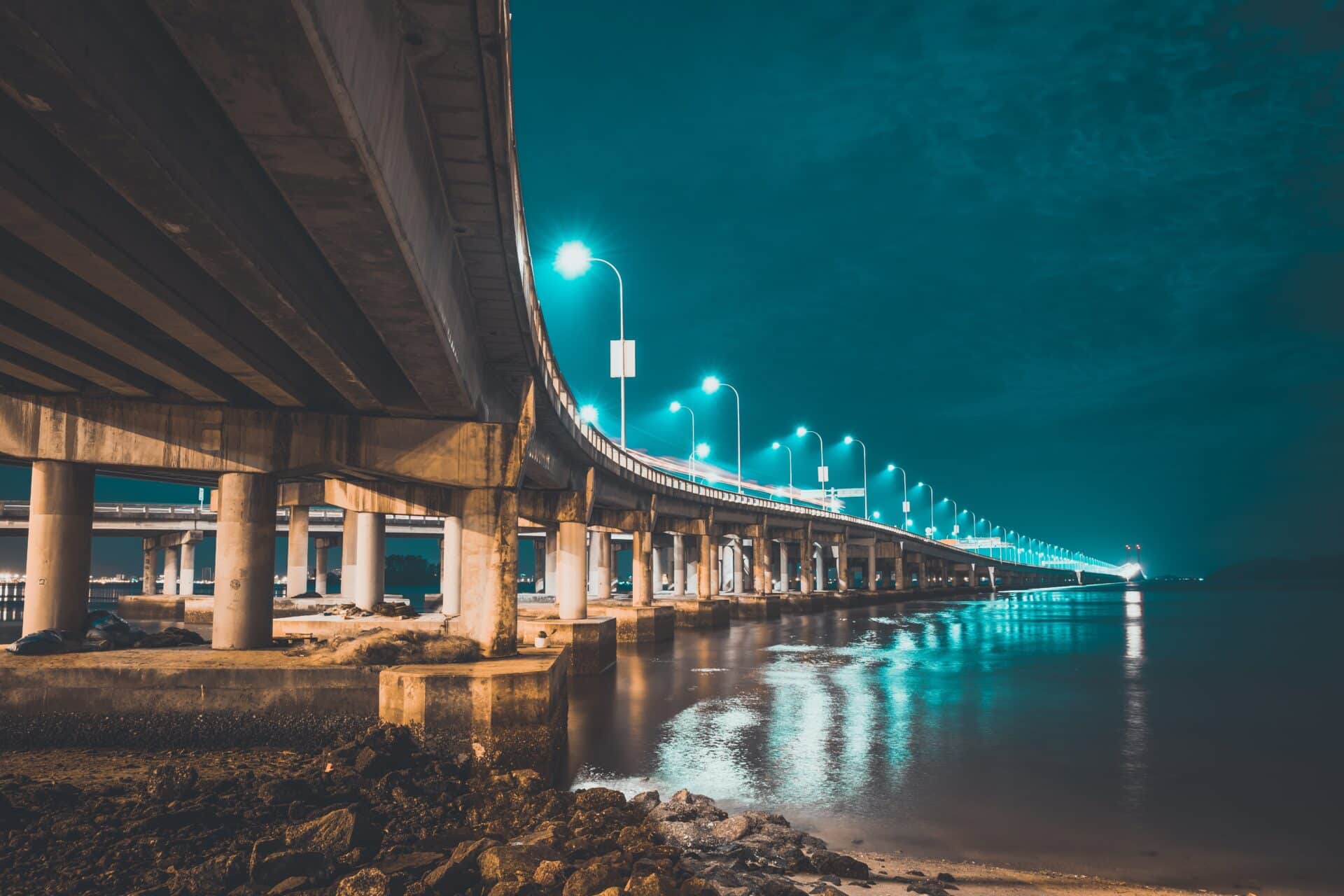
Nowadays, I prefer to fly if I can afford it. I never have to cross the bridges, merely look down upon them, two snakes upon blue, murky waters—gateways, passages to another world.
© Wan Phing Lim


